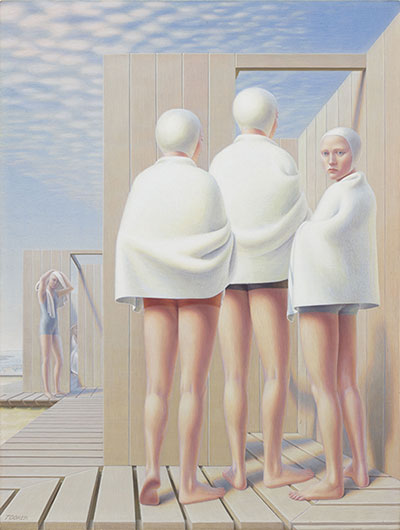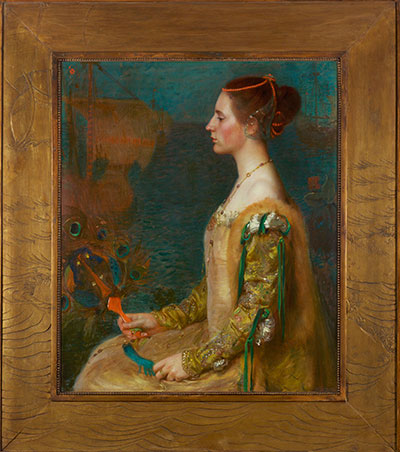Press Release - Rare, Important George Tooker Painting and a Neo-Renaissance Portrait Join The Huntington's Collections
Posted on Mon., May 22, 2017
Art Collectors’ Council supports the acquisition of George Tooker's Bathers (Bath Houses) and Albert Herter's Woman with a Fan

George Tooker, Bathers (Bath Houses), 1950, egg tempera on gessoed board, 20 3/8 x 15 3/8 in. The Huntington Library, Art Collections, and Botanical Gardens.
SAN MARINO, Calif.—At its annual meeting this spring, the Art Collectors’ Council of The Huntington Library, Art Collections, and Botanical Gardens voted to acquire a major painting by George Tooker (1920-2011), exemplar of the American “Magic Realist” group who was best known for capturing the angst of alienated urban dwellers in the mid-20th century. The rare and haunting Bathers (Bath Houses) (1950) becomes the first Tooker painting to join a museum collection in the western United States. The Council also acquired for The Huntington Woman with a Fan (ca. 1895), a Renaissance-style portrait by Beaux-Arts muralist and illustrator Albert Herter (1871–1950).
“This year was a particularly exciting one for the Art Collectors’ Council, whose members voted to add two very different paintings to the American art collection,” said Catherine Hess, chief curator of European art and interim director of the art collections at The Huntington. “The painting by Herter is luscious and nostalgic in tone while Tooker’s spare masterwork very much belongs to the mid-20th century, when it was painted. We are so fortunate, and grateful, for the Council’s passion, generosity, and collecting acumen.”
Founded in 1994, The Huntington’s Art Collectors’ Council supports the growth of the collections through active involvement in the acquisition process. This committed group of donors meets every spring to select works for acquisition presented by The Huntington’s curatorial staff. This year’s meeting was on April 29.
Both new acquisitions will go on public view later this month.
George Tooker, Bathers (Bath Houses), 1950, egg tempera on gessoed board, 20 3/8 x 15 3/8 in.

A rare and important early painting in Tooker's career, Bathers (Bath Houses) shows many of the qualities associated with the “Magic Realist” group. These mid-20th-century artists melded the dream-inspired imagery of Surrealism with the details of everyday life, discovering epic and universal qualities in the mundane. On the connection between his work and reality, Tooker once proclaimed, "I am after painting reality impressed on the mind so hard that it returns as a dream." Best known for his images of alienated urbanites in subways, government offices, and waiting rooms, Tooker painted the quiet desperation and isolation he saw in everyday American life.
With a serenity that borders on the spiritual, the fastidiously composed Bathers (Bath Houses) depicts a calm moment on a warm, sunlit day as beach-goers gather to dry themselves near a bath house. Its three primary figures stand wrapped in cloak-like towels in the foreground of a progressively receding seaside vista. Despite the stillness of the moment, however, a note of unrest lingers—two of the figures turn their backs to the viewer, elusive and anonymous, while a third stares directly out of the picture, just beyond the viewer.
“This incredibly rare painting shows Tooker at his best—effortlessly corralling the difficult medium of egg tempera to achieve luminous, disquieting grace,” said Chad Alligood, Virginia Steele Scott Chief Curator of American Art at The Huntington. “This milestone addition to the collection builds on other recent acquisitions to tell a broader story of midcentury American art.”
Born in Brooklyn and raised on Long Island, Tooker attended Phillips Academy in Andover, Mass., and Harvard, where he majored in English literature. After a brief stint in the Marine Corps, he attended the Art Students League of New York where he studied with Reginald Marsh, Kenneth Hayes Miller, and Harry Sternberg—all of whom are represented in The Huntington's collections. While there, he also met artist Paul Cadmus. Together, they traveled to Europe, where Tooker closely studied Italian Renaissance painting. Bathers (Bath Houses) shows the influence of this study, both in its use of egg tempera and its approach to composition.
The painting was owned for many years by a close friend of Tooker. It will be installed in the Virginia Steele Scott Galleries of American Art, inviting connections among works by Tooker’s colleagues.
Albert Herter (1871–1950), Woman with a Fan, ca. 1895, oil on canvas, 35 1/16 x 29 1/16 in.

The Herter name is not new to The Huntington’s history. In 2002, the Art Collectors’ Council purchased an inlaid ebonized secretary cabinet (ca. 1878) designed by the Herter Brothers furniture and decorating company; and Arabella Huntington, wife of the institution’s founder, Henry Huntington, commissioned several pieces from the firm.
“Albert Herter’s Woman with a Fan is one of those rare bridges that effortlessly connects The Huntington’s American art collections with its European collections,” said Catherine Hess. “We previously owned no painting that so perfectly defines the American Beaux-Arts moment, a period deeply relevant to Arabella Huntington, both through the art and design that she commissioned for her magnificent New York mansion and through the art of the Italian Renaissance that she loved and collected.”
Albert Herter, son of the firm’s founder, was an artistic prodigy, first exhibiting his work in the 1890 Paris Salon at the age of 19. He was a prolific muralist and illustrator whose commissions hang today in the Massachusetts State House, the Connecticut Supreme Court, the Wisconsin State Capitol, and Paris’s Gare de l’Est. His murals depicting the history of California can be seen in the Los Angeles Public Library. A portrait painting by Herter is relatively rare.
The subject in Woman with a Fan is a topic of some speculation. Her costume and the format of the painting are derived from Italian Renaissance portraits, such as the Huntington’s Portrait of a Woman, by Domenico Ghirlandaio (c. 1490, tempera on panel). A nameplate on the back of the frame reads “Miss Maude Bouvier,” referring to Jacqueline Kennedy’s grandmother. Herter spent time in the Hamptons during the early 1890s near the Bouviers and, in the 1920s, painted portraits of family members, but, because the nameplate is not original to the painting, the model is not known with certainty.
“Beyond its beauty and relevance to our collections, Woman with a Fan will perfectly complement our portraits by Cecilia Beaux and John Singer Sargent, or, just as easily, hang alongside our important Herter Brothers desk,” said Hess.
# # #
Contacts
Susan Turner-Lowe, 626-405-2147, sturner@huntington.org
Thea M. Page, 626-405-2260, tpage@huntington.org